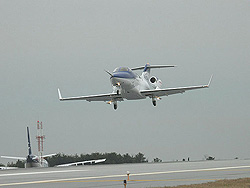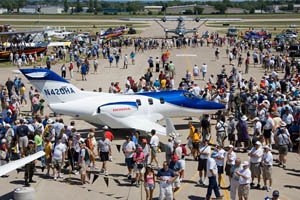Hondajet gets on the road to sell
 Honda began research into compact business jets in 1986, using engines provided by other manufacturers. The HF118 Turbofan Engine-equipped HondaJet experimental compact jet is the first Honda-developed aircraft to be outfitted with a Honda engine, a significant milestone for the company and the industry.
Honda began research into compact business jets in 1986, using engines provided by other manufacturers. The HF118 Turbofan Engine-equipped HondaJet experimental compact jet is the first Honda-developed aircraft to be outfitted with a Honda engine, a significant milestone for the company and the industry.
In December 2003 it was announced the HondaJet compact passenger jet equipped with Honda-developed HF118 jet engines, successfully completed initial flight tests at Piedmont Triad Airport in North Carolina, US. Now they announce they are bringing the very light jet HondaJet to this year’s EAA AirVenture Oshkosh. ( Billed as The World's Greatest Aviation Celebration) After making only a brief appearance for its unveiling at Airventure 2005, the HondaJet will stick around for the entire event this year - Corporate video here - essential viewing.
HondaJet’s over-the-wing engine-mount configuration helps eliminate the need for a structure to mount the engines to the rear fuselage and, thus, maximizes the space in the fuselage which can seat 6 passengers.
The HondaJet prototype reportedly gets 40% better fuel economy than comparable aircraft and has several major leading edge design and manufacturing technologies. Honda SMH-1 Natural Laminar Flow Wing Section
Honda SMH-1 Natural Laminar Flow Wing Section
Honda's proprietary SMH-1 achieves low drag and excellent performance at high speeds despite its relative thickness.
Laminar Flow Nose Section
The optimal design of the fuselage nose generates a laminar flow that reduces drag on the fuselage.
Over-the-Wing Engine-Mount
Optimal placement of the engine nacelles over the main wing may look odd but it improves aerodynamic performance at high speeds.
Co-cured Composite Fuselage
The co-cured composite and honeycomb sandwich structure combine to create a new composite structure that has enabled Honda to develop a lightweight fuselage with more interior space. Aluminum Main Wing
Aluminum Main Wing
The use of an integrally stiffened skin produces a smooth wing surface that promotes laminar flow.
Glass Cockpit
The aircraft is equipped with a state-of-the- art Garmin G1000 glass cockpit system.(For details) Information is efficiently presented on 3 large flat- panel flight displays.
The Hondajet gets 39.36 seat miles per gallon (6 seats). An SJ30 returns 22.5 seat miles per gallon (7 seats). A Learjet 31a returns 24.9 seat miles per gallon (8 seats).
At 1,000 lbs thrust class, Honda (and to a lesser degree GE) may be shooting for technology for cruise missile engine technology. Whether for upgrades to aging systems like the BGM-109 Tomahawks, or new ones like EADS Taurus (Japan might seek one in the future), this is a market for them to look to.
(The MBDA STORM SHADOW entered service with the Royal Air Force in 2003 and saw operational service in the Gulf during action in Iraq. STORM SHADOW / SCALP will be operated from Tornado, Rafale, Mirage 2000, Mirage 2000-5 Mk II, Eurofighter Typhoon and in the future, the F-35 Joint Strike Fighter. There will also be a Naval version for the two new aircraft carriers, this year next year some time , never))

No comments:
Post a Comment